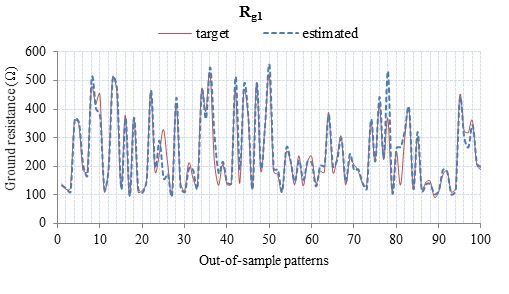Motivated by the need of engineers for a flexible and reliable tool for estimating and predicting grounding systems behavior, this study developed a model that accurately describes and forecasts the dynamics of ground resistance variation. It is well-known that grounding systems are a key of high importance for the safe operation of electrical facilities, substations, transmission lines and, generally, electric power systems. Yet, in most cases, during the design stage, electrical engineers and researchers have limited information regarding the terrain’s soil resistivity variation. Moreover, the periodic measurement of ground resistance is hindered, very often, by the residence and building infrastructure. The model, developed in the present study, consists of a nonlinear, nonparametric wavelet neural network (WNN), trained in field measurements of soil resistivity and rainfall height, observed the past four years. The proposed framework is tested in five (5) different grounding systems with different ground enhancing compounds, so that can be used for the evaluation of the behavior of several ground enhancing compounds, frequently used in grounding practice. The research results indicate that the WNN can constitute an accurate model for ground resistance forecasting and can be a useful tool in the disposal of electrical engineers. Therefore, this paper introduces the wavelet analysis in the field of ground resistance evaluation and endeavors to take advantage of the benefits of computational intelligence.
Grounding systems are an integral part of the protection system for electrical facilities and electric power systems against lightning and power frequency fault currents, as they are designed to dissipate high magnitude fault currents into the earth through a safe passage in the shortest possible time. Their purpose is to keep at minimum the ground potential rise (GPR), consequence of a discharging fault current, so as to ensure the safety of people and equipment from electric shock. Nevertheless, the assumption that any grounded object can be safely touched is not always correct. Under fault conditions, the ground potential rise could reach hazardous levels that may well lead to human losses and equipment destruction. Thus, for a well-designed grounding system in order to provide constant and full protection, technical measures are necessary to ensure a good and consistent behavior of the system throughout its life cycle. As far as the power frequency resistance is concerned, a grounding system must maintain a low resistance in respect to remote earth during its service. In this way, the decline in potential rise an restrain the high values of step and touch voltages in the facility and its vicinity, which are able to jeopardize human lives.
In the last decades the usage of ground enhancing compounds for soil alleviation and decreasing the ground resistance value becomes more and more popular in engineering field. Despite the recommendations of the standards, the periodic measurement of ground resistance is hindered, very often, by the residence and building infrastructure. Moreover, many times it is essential for engineers to have an estimation of the behavior of constructed or, in design stage, grounding systems over time. This work endeavors to develop a novel tool for estimating and forecasting the ground resistance values of several grounding systems,based on soil resistivity measurements at the location of interest and on local rainfall data, using WNN.
A WNN based on back-propagation algorithm with batch training method has trained in order to forecast the variation of ground resistance. The present paper endeavors to construct WNN models applicable on ground resistance forecasting, as an alternative to previous methodology developed. The developed WNN is a useful and reliable tool for assessing the performance and behavior of several ground enhancing compounds in grounding systems, a task which is to be facilitated with the proposed methodology. The presented results, in this study, show that the WNN is able to forecast with great accuracy the ground resistance for all rods.
IEC 60364-41 recommend the national standards to determine particular maximum values of ground resistance for building electrical installations. Thus, electrical engineers need to have a reliable and flexible tool for the estimation of ground resistance during the whole year, since ground resistance variations may be significant with respect to time and rainfall. This is very important, particularly, in the design of a grounding system. Therefore, the significance and the practical value of ground resistance forecasting become indisputable and, from the results of this study, it seems that the proposed WNN methodology offers a valuable tool for this purpose. The convergence results between the target and the estimated values as well the low SMAPE values show that the network performance is quite high. Moreover, the proposed WNN methodology is able to model the relationship among parameters such as rainfall, soil resistivity and compound composition, aiming the best ground resistance estimation. Further work on variable selection methods could yield better results for the network. More particularly, a careful study of ground resistance in function of rainfall may lead to the determination of suitable time windows of rainfall as input vector to networks. Perhaps this will result in a simpler WNN architecture, smaller training times and more precise forecasts.
| In-sample | Out-of-sample | ||
| Rg1 | Variables: rd, rw, ρ1d, ρ4d, ρ1w, ρ6w, ρ8w, ρ1m, ρ2m HU: 13 | ||
| NMSE | 0.0035 | 0.0768 | |
| SMAPE % | 1.17 | 4.04 | |
| R2 | 0.9983 | 0.9644 | |
| R2 adjusted | 0.9965 | 0.9232 | |
| Rg2 | Variables: ρ2d, ρ4d, ρ8d, ρ4w, ρ1m, ρ2m HU: 16 | ||
| NMSE | 0.0188 | 0.0674 | |
| SMAPE % | 1.17 | 2.86 | |
| R2 | 0.9905 | 0.9665 | |
| R2 adjusted | 0.9812 | 0.9326 | |
| Rg3 | Variables: rd, rw, rm, ρ1d, ρ2d, ρ4d, ρ6d, ρ1w, ρ6w, ρ8w, ρ1m HU: 12 | ||
| NMSE | 0.0037 | 0.0205 | |
| SMAPE % | 2.25 | 4.63 | |
| R2 | 0.9981 | 0.9898 | |
| R2 adjusted | 0.9963 | 0.9795 | |
| Rg4 | Variables: ρ1d, ρ8d, ρ4w, ρ1m, ρ2m HU: 15 | ||
| NMSE | 0.0105 | 0.0371 | |
| SMAPE % | 1.33 | 2.79 | |
| R2 | 0.9948 | 0.9844 | |
| R2 adjusted | 0.9895 | 0.9629 | |
| Rg5 | Variables: ρ4d, ρ6d, ρ8d, ρ2w, ρ1m HU: 12 | ||
| NMSE | 0.0031 | 0.2536 | |
| SMAPE % | 2.35 | 7.57 | |
| R2 | 0.9985 | 0.8788 | |
| R2 adjusted | 0.9969 | 0.7464 | |
| NMSE: | normalized mean squared error | ||
| SMAPE: | symmetric mean absolute percentage error | ||
| R2: | coefficient of determination | ||
The study has been published in Electric Power Systems Research and it is a collaborative work of Dr. Antonios K. Alexandridis from the University of Kent with Vasilios P. Androvitsaneas, Ioannis F. Gonos and Ioannis Stathopoulos from the National Technical University of Athens and Georgios D. Dounias from the University of the Aegean.



Thanks for the articles, very useful